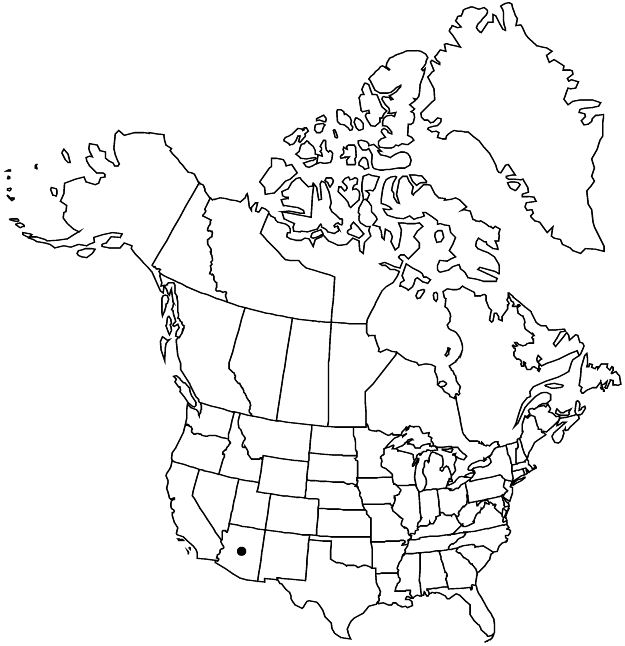Waltheria detonsa
Smithsonian Contr. Knowl. 5(6): 24. 1853.
Plants to 5.2 dm, finely minutely ash-gray tomentose, overlayer sparsely pubescent, hirsutulous. Stems mostly 1–2 mm wide, nodes slightly extended to 0.7 mm. Leaves: stipules narrowly triangular, 3–4 mm, apex geniculate or curved; petiole 0.6–0.8 mm wide; blade discolor, abaxially gray-olive, adaxially darker, reddish-brown, ovate-elliptic, to 6 × 4.5 cm, slightly resinous, base widely cuneate, truncate, or rounded, margins crenate-dentate or crenate-denticulate, apex widely obtuse, rounded, surfaces: abaxial sparsely to densely tomentose, adaxial densely tomentulose, trichome rays 0.2–0.4 mm. Inflorescences lax, paniculiform, lateral branches to 15 cm, clusters 5 or 6, oblong or deltate, with 1 terminal flower, the 2 or more dichasia (cincinni) arising from accessory shoots below it; bracteoles free, bracts unequal, major bract of primary cyme elliptic, oblong, ovate, or obovate, 0.8–2.2 mm wide, apex obtuse or rounded, (2–) 3-cuspidate or 3-dentate, sharply pointed “cuspidate” incised lobes linear, narrowly triangular, or triangular, unequal, to 1.7 m long; minor bracts lanceolate. Flowers sessile; calyx 3.5–4.8 mm, densely to sparsely tomentulose, and hirsutulous and sparsely hirsute, tube 1.8–2.4 mm, lobes 1.5–2.4 mm; petals bright-yellow proximally, pale-yellow distally, obtriangular, 3.7–4 × 1–1.4 mm, apex truncate, minutely puberulent across apical margin, trichome rays 1–2, abaxial surface minutely stellate-puberulent, stellate trichome rays dense, 8–10, adaxial surface sparsely pilose or villous, claw adherent for (0.4–) 0.8–1 to stamen tube base; stamens 2.6–3 mm, tube 2.2 mm, red-papillose distally; anthers (0.7–) 0.9–1 mm, base sagittate; pistil 2.6–3.6 mm; ovary velutinous-hirsute apically; styles 1.3 × 0.1 mm, lateral, stellate-hirsutulous; stigmas 10–26-branched, and upper sides of valve suture. Seeds dark chocolate brown with light-brown zone, obovoid-obconic, 1.6–2.3 × 1–1.4 × 1.2–1.3 mm, apex broadly rounded, nearly truncate in lateral view, smooth, apex with very fine raised concolorous line.
Phenology: Flowering and fruiting late spring–fall.
Habitat: Canyons, exposed boulders, granitic slopes, foothills
Elevation: 900–1400(–1500) m
Distribution

Ariz., Mexico (Baja California Sur), Mexico (Chihuahua), Mexico (Jalisco), Mexico (Sinaloa), Mexico (Sonora), Mexico (Zacatecas)
Discussion
In Arizona, Waltheria detonsa occurs in the Baboquivari, Las Guijas, and Santa Catalina mountains, Buenos Aires National Wildlife Refuge, Coronado National Forest, Huachuca foothills (Fort Huachuca), and, presumably, still at the type locality in Santa Cruz County on Sonoita Creek, near Deserted Rancho.
Some authors have placed Waltheria detonsa under W. indica or its synonym W. americana, or misidentified it as such. Specimens of W. detonsa have also been misidentified as W. acapulcensis Rose, W. albicans Turczaninow, W. paniculata Bentham, or W. preslii Walpers.
The flowers of Waltheria detonsa usually have the stigma exceeding the stamens by 0.5–1 mm. I have seen a distylous thrum-flowered plant with separation between stamens and stigma from Mexico in Sinaloa (Lamb 327, US), and a possible thrum from Chihuahua (Palmer 20, NY).
Selected References
None.
Lower Taxa
"/2" is not declared as a valid unit of measurement for this property.
